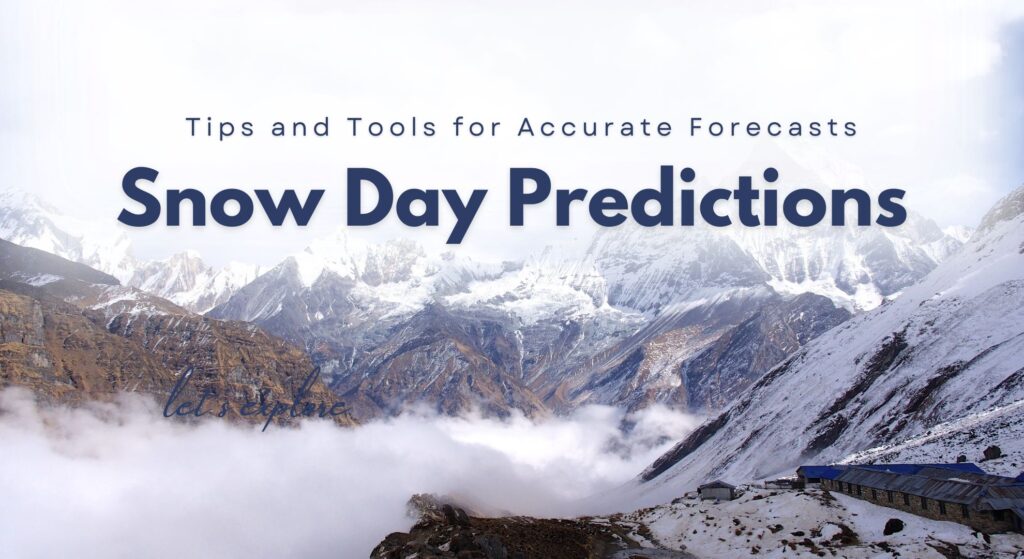Snow day predictors are tools that forecast the likelihood of schools being closed due to snowy weather. These predictors are valuable for students, parents, and school administrators, providing early warnings and helping plan for unexpected weather disruptions. This article will explore how snow day predictors work, their reliability, and the various methods used to forecast snow days.
What Are Snow Day Predictors?
Snow day predictors are systems or tools designed to forecast whether schools will close due to snow. They use various methods to assess weather conditions and provide an estimate of the probability of a snow day. These predictors can range from simple online tools to complex algorithms that analyze weather data.
How Do Snow Day Predictors Work?
Snow day predictors work by analyzing weather forecasts, historical weather data, and local conditions. They take into account factors such as temperature, precipitation, and the timing of snow. By combining these elements, the predictors estimate the likelihood of snow affecting school operations.
Weather Forecast Analysis
One crucial component of snow day predictors is the analysis of weather forecasts. Predictors use data from meteorological services to assess the expected snowfall and temperature. This data helps determine if the conditions will be severe enough to warrant school closures.
Historical Weather Data
Historical weather data plays a significant role in predicting snow days. By examining past weather patterns, predictors can identify trends and make more accurate forecasts. This historical data helps adjust the predictions based on previous snowfall events and their impact on school closures.
Types of Snow Day Predictors
Several types of snow day predictors are available, each with its approach and level of complexity. Understanding these types can help users choose the most suitable tool for their needs.
Online Snow Day Predictors
Online snow day predictors are user-friendly tools available on various websites. These tools provide forecasts based on weather data and historical patterns. Users typically enter their location to receive predictions specific to their area.
School District Predictors
Some school districts have their own snow day predictors. These systems are tailored to the specific needs of the district and take into account local weather patterns and school policies. They are often used in conjunction with broader weather forecasts.
Accuracy of Snow Day Predictors
The accuracy of snow day predictors can vary. Factors such as the quality of the data and the methods used can impact the reliability of the predictions. Understanding the limitations of these tools can help users interpret the forecasts more effectively.
Data Quality
The quality of the data used by snow day predictors is crucial. Accurate and up-to-date weather information leads to more reliable forecasts. Predictors that use high-quality data from reputable sources are generally more accurate.
Methodology
Different predictors use various methodologies to forecast snow days. Some rely on complex algorithms, while others use simpler statistical models. The methodology can affect the accuracy of the predictions, so it’s important to understand how each predictor operates.
Benefits of Using Snow Day Predictors
Using snow day predictors offers several benefits, from better planning to reducing uncertainty. Here are some key advantages of using these tools.
Early Warnings
Snow day predictors provide early warnings of potential school closures. This allows students, parents, and school administrators to plan accordingly, minimizing disruptions caused by unexpected weather.
Improved Planning
With accurate predictions, families can make better plans for snow days. Parents can arrange childcare or adjust their work schedules, while students can prepare for potential school closures.
Limitations of Snow Day Predictors
Despite their benefits, snow day predictors have limitations. Being aware of these limitations can help users manage their expectations and plan accordingly.
Variable Accuracy
The accuracy of snow day predictors can vary based on factors such as data quality and methodology. Users should be cautious and consider multiple sources of information when planning for snow days.
Reliance on Forecasts
Snow day predictors rely on weather forecasts, which can change rapidly. Users should be prepared for the possibility that forecasts may not always be accurate, especially in areas with unpredictable weather patterns.
Table: Benefits and Limitations of Snow Day Predictors
| Benefits | Limitations |
|---|---|
| Provides early warnings | Accuracy can vary |
| Helps with planning | Relies on forecasts that may change |
| Reduces uncertainty | May not account for all local factors |
Snow day predictors are valuable tools for forecasting school closures due to snow. By analyzing weather data and historical patterns, these predictors help users plan for potential disruptions. While they offer benefits such as early warnings and improved planning, users should be aware of their limitations and rely on multiple sources of information to make the best decisions.



